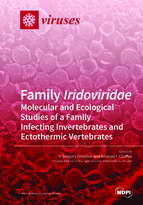Family Iridoviridae: Molecular and Ecological Studies of a Family Infecting Invertebrates and Ectothermic Vertebrates
A special issue of Viruses (ISSN 1999-4915). This special issue belongs to the section "Animal Viruses".
Deadline for manuscript submissions: closed (28 February 2019) | Viewed by 70562
Special Issue Editors
Interests: viruses infecting lower vertebrates; specifically Iridoviruses; anti-viral immune responses in cold-blooded vertebrates; viral taxonomy
Special Issues, Collections and Topics in MDPI journals
Interests: ranavirus distributions; ranavirus ecology; ranavirus community dynamics; mathematical modelling of ranavirus dynamics; ranavirus phylogenetics
Special Issue Information
Dear Colleagues,
Iridovirids, a generic term describing viruses within the family Iridoviridae, comprise a diverse array of large, icosahedral, double-stranded DNA viruses that infect insects, other invertebrates, and three classes of ectothermic vertebrates (bony fish, reptiles, and amphibians). Iridovirid infections trigger considerable morbidity and have been linked to die-offs among ecologically- and commercially-important fish, reptiles, and amphibians. In this Special Issue of Viruses we will provide a representative sample of current research focused on cellular, molecular and ecological aspects of iridovirid biology. Although clinical disease linked to iridovirid infection, i.e., lymphocystis disease, has been known since the turn of the 20th century, concerted study of iridovirid biology did not begin until Allan Granoff’s identification of frog virus 3 (FV3) in the mid-1960s. Through his efforts and those of others, FV3 became the best characterized member of the family. These studies focused mainly on replicative events in FV3-infected cells and defined the essential elements of virus replication. Although early work was centered primarily on molecular aspects of FV3, research efforts during the last 30 years have expanded to include numerous studies on the ecology of iridovirid infections, replicative events among other species within the genus Ranavirus, as well as other genera within the family, and immune responses to iridovirid infections. Recently, genomic sequence analysis of over 40 members of the family generated a phylogenetically robust basis for our understanding of viral taxonomy and provided a facile way to identify and classify newly identified viruses. In addition, sequence information has provided the basis for numerous studies of viral gene function using siRNA- and antisense morpholino oligonucleotide-mediated knock down, knock out and conditionally-lethal mutants, and ectopic expression studies. Using these approaches, the functions of several viral replicative and immune-modulating proteins have been determined. Moreover, study of virus-encoded immune evasion proteins combined with ongoing research into host anti-viral immunity has provided insights into the evolutionary origins of the vertebrate immune system and may further the development of protective vaccines. The world of iridovirid research has expanded greatly in the last 30 years and we look forward to providing a venue highlighting different facets of research focused on the family Iridoviridae.
Prof. Dr. Gregory Chinchar
Assoc. Prof. Dr. Amanda Duffus
Guest Editors
Manuscript Submission Information
Manuscripts should be submitted online at www.mdpi.com by registering and logging in to this website. Once you are registered, click here to go to the submission form. Manuscripts can be submitted until the deadline. All submissions that pass pre-check are peer-reviewed. Accepted papers will be published continuously in the journal (as soon as accepted) and will be listed together on the special issue website. Research articles, review articles as well as short communications are invited. For planned papers, a title and short abstract (about 100 words) can be sent to the Editorial Office for announcement on this website.
Submitted manuscripts should not have been published previously, nor be under consideration for publication elsewhere (except conference proceedings papers). All manuscripts are thoroughly refereed through a single-blind peer-review process. A guide for authors and other relevant information for submission of manuscripts is available on the Instructions for Authors page. Viruses is an international peer-reviewed open access monthly journal published by MDPI.
Please visit the Instructions for Authors page before submitting a manuscript. The Article Processing Charge (APC) for publication in this open access journal is 2600 CHF (Swiss Francs). Submitted papers should be well formatted and use good English. Authors may use MDPI's English editing service prior to publication or during author revisions.
Keywords
- iridovirus
- Iridoviridae
- ranavirus
- viral pathogenesis
- modeling of infectious disease
- vaccine development
- elucidation of viral gene function
- anti-viral immune responses
- host-virus interaction
- viral immune evasion
- viral ecology







